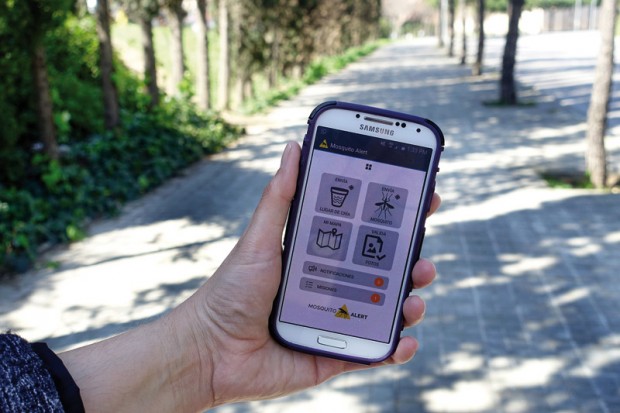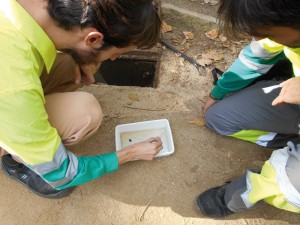The emergence or re-emergence of certain diseases boils down to a change in the balance between three things – the host, the pathogen and the environment – and this change is due to many factors, most of them caused by human activity, in particular climate change and globalisation.

Mosquito Alert is a mobile app that enables people to report the presence of tiger mosquitoes and possible breeding sites in urban areas, along with photos to verify the data.
Photo: Vicente Zambrano
Cities are relatively new ecosystems and they do not have a system for regulating animal populations. In this context, certain species adapt and multiply uncontrollably until they become urban pests. This is true, for example, of pigeons, gulls, mosquitoes, rats, cockroaches and parakeets.
When some of these species live alongside people in the same geographical area, it can lead to environmental and economic problems, such as unhygienic spaces, damage to street furniture and private property, contamination of food and water and the transmission of diseases.
The authorities work to identify the pests that inhabit the urban environment and the risks they may cause. Research involves identifying and recording the prevalence of different diseases, monitoring the natural population of existing host species, the geographic distribution of pests and their methods of transmission.
The Administration regularly implements programmes to reduce the negative impact of these pests both in big cities and small towns. The goal is to keep the harmful species below the tolerance threshold, using, firstly, elements that kill them off naturally and then integrated pest control methods (biological, physical, chemical, etc.) that are compatible with the environment and with public health.
Emerging and re-emerging diseases
Epidemiological vigilance involves studying the species population that has to be controlled and identifying the diseases passed between animals and humans and their global impact, in order to prevent risks to animal and public health and species conservation and to decide which strategies best meet the needs of the geographical area.
We know that around 60% of organisms that are infectious to humans are responsible for zoonotic diseases. Around 80% of these diseases are transmitted by pests such as ticks, fleas and mosquitoes, and the vast majority of them are known as emerging or re-emerging diseases. Emerging diseases are those that have recently appeared for the first time in a particular population or geographical area and re-emerging diseases are those that have existed in the past and have increased in incidence or distribution in the geographical area in which they are found. Vector-borne diseases make up over 17% of all infectious diseases and lead to more than a million deaths each year.
The emergence or re-emergence of certain diseases boils down to the absence of or change in balance between three agents: host, pathogen and environment. This change in balance can be due to numerous different factors, most of them the result of human activity, particularly climate change; much more intercontinental travel and migration; the transportation of animals; deforestation and urbanization; crop and livestock farming; overpopulation; poverty; the loss of biodiversity; and the introduction of new species.
Climate change and globalisation: key factors
Climate change is one of the key factors in the spread of pests. Global warming has a direct effect on disease-spreading vectors (agents that can propagate or transmit a disease from one organism to another). Temperature rises allow many vectors to develop more easily, thus increasing their distribution area. Additionally, globalisation involves large-scale transportation of goods, which also brings about the unintentional movement of organisms. These journeys are the main reason that the geographical distribution of certain diseases is growing. For example, the presence of the tiger mosquito, a species native to Asia that is now invading many parts of the world, is related to the transportation of used tires and/or gardening products.
Not all pests have the same impact on public health. Nonetheless, it is worth highlighting a few of the biggest transmitters of diseases. Vector-borne diseases are a group of emerging and re-emerging infectious diseases that currently pose a serious threat to Europe as a whole. Among the vector-borne diseases that present a real risk, we find malaria, dengue fever, the Chikungunya virus, Zika and Western Nile virus, and the more recent case of haemorrhagic fever caused by the tick-borne Crimean-Congo virus.
The tiger mosquito in Barcelona
The Council’s measures to control the tiger mosquito aim to prevent its proliferation and reduce its presence, minimizing its negative effects for the population (inconvenience and the transmission of diseases, mainly). With this in mind, Barcelona’s Public Health Agency (ASPB) has rolled out its mosquito vigilance and control programme in public spaces, to keep the species under control. This roll-out is particularly complex in a city of Barcelona’s size, with over one and a half million inhabitants, and because of the abundance of places that are ideal for the proliferation of mosquitoes, such as the 75,000 rainwater drains and the more than 300 ornamental fountains in public spaces.

Technicians from the Barcelona Public Health Agency (ASPB) carrying out mosquito control and monitoring tasks.
Photo: Barcelona Public Health Agency
One of the main aims of the programme is to identify the vector’s potential areas of activity by collecting data on mosquito presence. Every year, from April to November, we conduct a programme of continuous vigilance of the hotspots – the places where significant tiger mosquito activity was detected the previous year. The general public is also a source of basic information and we carry out inspections in the affected areas. Another priority is to explore new tools for improving the system. This is why the ASPB has joined up with the Mosquito Alert project, which has developed a mobile app of the same name that lets members of the public alert others to the presence of the tiger mosquito. The data collected through all these different channels allow us to prioritise and organise a range of prevention and control activities.
Controlling arboviruses
Arboviruses are diseases caused by a group of viruses transmitted by arthropods. Because of the high incidence of these diseases, in 2013 the ASPB, in partnership with Hospital Clínic de Barcelona university hopsital, set up a pilot project to monitor arboviruses and reduce their risk of transmission. The success of this project, along with the publication of the Catalan Government’s Procedures for the vigilance and control of mosquito-borne arboviruses in Catalonia, led to this vigilance system being rolled out all over Catalonia in 2014, in coordination with all the relevant agencies. It also led to improved arbovirus detection, to the creation of the Epidemiological Vigilance Network and to the regulation of notification systems for diseases that must be declared and for outbreaks of epidemics. Because of this, dengue and chikungunya have come to be classed as notifiable diseases in Catalonia. Lastly, the globally important public health emergency declared by the WHO on the 1st February 2016, relating to microcephaly and other neurological conditions (such as Guillain-Barré Syndrome (GBS)) associated with the Zika virus, also brought improvements to the communication systems around this disease.
The constant appearance of imported cases of dengue, chikungunya and, more recently, Zika, to the area, along with the autochthonous cases detected in France, very close to our own border, have emphasized the need to establish protocols that include virus monitoring actions, early detection and rapid confirmation of diagnoses, as well as proper entomological and animal monitoring to determine the level or risk to human health and to implement measures for immediate intervention. But for that, there has to be coordinated action between all the parties involved; in other words, entomologists, animal health experts, epidemiologists, clinics and virologists.
The system for monitoring and controlling arboviruses therefore revolves around two key elements. Firstly, the Epidemiology Service takes responsibility for filtering cases of any patients with dengue, chikungunya or Zika who arrive in the city in the viraemic phase (in other words, the period in which the person has enough of the virus in their blood to make it possible for them to transmit the disease to a healthy person by way of a mosquito vector bite). The Service also carries out an epidemiological questionnaire that includes a number of recommendations and gathers information to follow up on the required actions and monitor the patient: personal data, places to which he or she has travelled, previous bites, places visited during the viraemic phase, and so on.
Once this epidemiological questionnaire has been completed, the patients who have come to the city in the viraemic phase are reported to the Department of Urban Pest Control and Vigilance (SVIPLA), which then contacts the person to reinforce the recommendations for prevention and protection, inspect their home and nearby streets for insects and assess the need to carry out other inspections, based on the places the patient has visited and how long he or she stayed there during the viraemic period (the homes of family members or friends, workplace, places of leisure, etc.). The purpose of all these actions is to identify the presence of the vector and reduce it to minimize the possibility of transmission.
Alongside these tasks, the inspected places are also monitored using traps or other methods to capture the mosquitos, so they can then be analysed and the presence of the virus in the vector can be ruled out, which, if it is found, increases the risk of transmission and involves taking further steps to control it. If the presence of mosquitoes or the virus is detected, pest control methods are used (larvicide or adulticide) and regular follow-ups are scheduled in the area until the vector is no longer active.
Public involvement
To be effective, pest control in the city requires a high level of involvement from the public, as many breeding sites are found in private properties, especially in the case of the tiger mosquito. That is why public awareness is crucial as we try to spread knowledge of this species of mosquito and its behaviour, the risks inherent in its proliferation, how to protect yourself and the pest control methods that people can use to reduce or eliminate mosquito breeding sites in the domestic environment.
To conclude: the pests that live with us in our cities and towns can cause a range of different problems, including the transmission of diseases. To apply methods of pest control that reduce risks and minimize the global impact on public health, we need a monitoring system that identifies the health status of vector populations, their capacity to transmit disease and the geographical distribution of these diseases.



